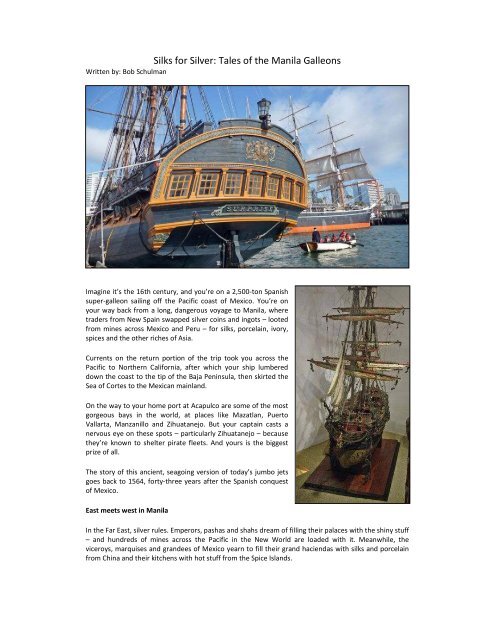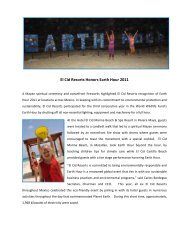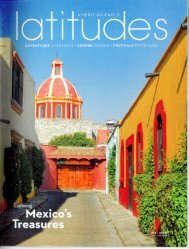Silks for Silver: Tales of the Manila Galleons - El Cid
Silks for Silver: Tales of the Manila Galleons - El Cid
Silks for Silver: Tales of the Manila Galleons - El Cid
- No tags were found...
Create successful ePaper yourself
Turn your PDF publications into a flip-book with our unique Google optimized e-Paper software.
<strong>Silks</strong> <strong>for</strong> <strong>Silver</strong>: <strong>Tales</strong> <strong>of</strong> <strong>the</strong> <strong>Manila</strong> <strong>Galleons</strong>Written by: Bob SchulmanImagine it’s <strong>the</strong> 16th century, and you’re on a 2,500-ton Spanishsuper-galleon sailing <strong>of</strong>f <strong>the</strong> Pacific coast <strong>of</strong> Mexico. You’re onyour way back from a long, dangerous voyage to <strong>Manila</strong>, wheretraders from New Spain swapped silver coins and ingots – lootedfrom mines across Mexico and Peru – <strong>for</strong> silks, porcelain, ivory,spices and <strong>the</strong> o<strong>the</strong>r riches <strong>of</strong> Asia.Currents on <strong>the</strong> return portion <strong>of</strong> <strong>the</strong> trip took you across <strong>the</strong>Pacific to Nor<strong>the</strong>rn Cali<strong>for</strong>nia, after which your ship lumbereddown <strong>the</strong> coast to <strong>the</strong> tip <strong>of</strong> <strong>the</strong> Baja Peninsula, <strong>the</strong>n skirted <strong>the</strong>Sea <strong>of</strong> Cortes to <strong>the</strong> Mexican mainland.On <strong>the</strong> way to your home port at Acapulco are some <strong>of</strong> <strong>the</strong> mostgorgeous bays in <strong>the</strong> world, at places like Mazatlan, PuertoVallarta, Manzanillo and Zihuatanejo. But your captain casts anervous eye on <strong>the</strong>se spots – particularly Zihuatanejo – because<strong>the</strong>y’re known to shelter pirate fleets. And yours is <strong>the</strong> biggestprize <strong>of</strong> all.The story <strong>of</strong> this ancient, seagoing version <strong>of</strong> today’s jumbo jetsgoes back to 1564, <strong>for</strong>ty-three years after <strong>the</strong> Spanish conquest<strong>of</strong> Mexico.East meets west in <strong>Manila</strong>In <strong>the</strong> Far East, silver rules. Emperors, pashas and shahs dream <strong>of</strong> filling <strong>the</strong>ir palaces with <strong>the</strong> shiny stuff– and hundreds <strong>of</strong> mines across <strong>the</strong> Pacific in <strong>the</strong> New World are loaded with it. Meanwhile, <strong>the</strong>viceroys, marquises and grandees <strong>of</strong> Mexico yearn to fill <strong>the</strong>ir grand haciendas with silks and porcelainfrom China and <strong>the</strong>ir kitchens with hot stuff from <strong>the</strong> Spice Islands.
So East and West made a deal to swap <strong>the</strong>ir goods. The tradingpost would be at <strong>Manila</strong>, a Spanish colony already serving as acommercial link between Europe and Asia. To get <strong>the</strong>re fromMexico, <strong>the</strong> westerners came up with a new breed <strong>of</strong> galleons,big enough – some were nearly as long as a football field – tocarry hundreds <strong>of</strong> thousands <strong>of</strong> silver pesos (coins about <strong>the</strong> size<strong>of</strong> a U.S. silver dollar) and as many as 1,000 traders, crewmen,soldiers, settlers and convict laborers traveling to <strong>the</strong> Far East.The vessels went down in <strong>the</strong> Spanish history books as <strong>the</strong> “Naosde China” (ships <strong>of</strong> China), in <strong>the</strong> Chinese books as whattranslated to “<strong>the</strong> <strong>Silver</strong> Argosies,” and in <strong>the</strong> English books, “<strong>the</strong><strong>Manila</strong> galleons.”Their eastbound voyages started at Acapulco, Mexico’s chiefwestern seaport, where <strong>the</strong> galleons were loaded with silver andsupplies <strong>for</strong> Spain’s overseas colonies. They sailed out <strong>of</strong> <strong>the</strong> bayunder protection <strong>of</strong> <strong>the</strong> five gun-studded bastions <strong>of</strong> Fort SanDiego, <strong>the</strong>n latched on to <strong>the</strong> westerly trade winds to arrive in <strong>Manila</strong> two to three months later.It was a lot harder getting back. The ships, now re-loaded with Asian treasures along with returningpassengers, sometimes had to sail as far north as Japan and even <strong>the</strong> Aleutians to find winds andcurrents heading back across <strong>the</strong> Pacific. Usually, <strong>the</strong>y ended up <strong>of</strong>f <strong>the</strong> Cali<strong>for</strong>nia coast near CapeMendocino (170 miles north <strong>of</strong> modern-day SanFrancisco); from <strong>the</strong>re, <strong>the</strong>y caught winds blowing <strong>of</strong>fand on down <strong>the</strong> shorelines <strong>of</strong> Cali<strong>for</strong>nia, BajaCali<strong>for</strong>nia and western Mexico.Some galleons stopped at a customs station at SanBlas on <strong>the</strong> Mexican mainland.The trip from <strong>Manila</strong> to Acapulco typically took five orsix months, and it was fraught with perils. Not only did<strong>the</strong> sailors have to worry about storms, trickycurrents, starvation, dehydration, scurvy, and rocky,fog-shrouded shorelines, but <strong>the</strong>ir exotic cargoes were<strong>the</strong> prize targets <strong>of</strong> pirates, privateers (legalizedpirates) and wartime enemies <strong>of</strong> Spain.No wonder <strong>of</strong> all <strong>the</strong> galleons’ voyages – <strong>the</strong>y trekkedback and <strong>for</strong>th across <strong>the</strong> Pacific singly or in pairs <strong>for</strong>250 years until Mexico gained its independence fromSpain – around one out <strong>of</strong> five trips ended in somekind <strong>of</strong> disaster.Prize prey <strong>for</strong> <strong>the</strong> jolly rogerIt didn’t take a galleon scientist to figure out when <strong>the</strong> homeward-bound ships would show up <strong>of</strong>f <strong>the</strong>coast <strong>of</strong> Mexico. They usually left Acapulco in January or February to take advantage <strong>of</strong> <strong>the</strong> season’ssteady winds to <strong>the</strong> Philippines. They’d arrive in <strong>Manila</strong> in late spring, and after a few months <strong>of</strong> tradingwould start <strong>the</strong> homeward voyage around July – which would normally put <strong>the</strong>m along <strong>the</strong> Mexicanshoreline heading to Acapulco by mid-winter.
So all <strong>the</strong> pirates had to do (when <strong>the</strong>y weren’t o<strong>the</strong>rwise picking <strong>of</strong>f coastal commerce) was to find acozy harbor and sit around <strong>for</strong> a month or so waiting <strong>for</strong> <strong>the</strong> galleons’ enormous sails to pop up on <strong>the</strong>horizon.The “pirate gauntlet” began at <strong>the</strong> tip <strong>of</strong> <strong>the</strong> Baja Peninsula, where <strong>the</strong> galleons stocked up on freshwater, fruits and vegetables at an eden-like estuary at San Jose del Cabo (now part <strong>of</strong> <strong>the</strong> huge resortcomplex <strong>of</strong> Los Cabos) be<strong>for</strong>e crossing <strong>the</strong> Sea <strong>of</strong> Cortes. While loading up, <strong>the</strong>y were sitting ducks <strong>for</strong><strong>the</strong> sc<strong>of</strong>flaws <strong>of</strong> <strong>the</strong> seas.Pirates hid behind islands <strong>of</strong>f <strong>the</strong>beaches <strong>of</strong> Mazatlan.Those that made it across <strong>the</strong> Sea <strong>of</strong>Cortes faced similar attacks along <strong>the</strong>Mexican mainland when <strong>the</strong>y stoppedto replenish <strong>the</strong>ir supplies. First up was<strong>the</strong> bay <strong>of</strong> Mazatlan, where three<strong>of</strong>fshore islands provided natural hidingplaces <strong>for</strong> <strong>the</strong> swashbucklers. After thatcame attacks from hidden coves dotting<strong>the</strong> 60-mile-long bay <strong>of</strong> Puerto Vallarta.And a little fur<strong>the</strong>r down <strong>the</strong> coast, agood number <strong>of</strong> galleons were picked<strong>of</strong>f while trying to load up at <strong>the</strong> twosecluded bays at Manzanillo.At <strong>the</strong> end <strong>of</strong> <strong>the</strong> gauntlet <strong>of</strong> piratehideaways was Zihuatanejo. If <strong>the</strong> galleons could make it past <strong>the</strong>re, <strong>the</strong> remaining 150 miles to <strong>the</strong>irhome port at Acapulco were usually a breeze.Zihuatanejo’s snug, meandering bay, however, was a <strong>for</strong>midable hurdle. Often lurking <strong>the</strong>re were shipsflying <strong>the</strong> Jolly Roger under <strong>the</strong> command <strong>of</strong> notorious swashbucklers <strong>of</strong> <strong>the</strong> likes <strong>of</strong> Sir Francis Drake,William Draper and Thomas Cavendish. What's more, towns around <strong>the</strong> bay were home to many <strong>of</strong> <strong>the</strong>pirate crews and <strong>the</strong>ir families.Local historians tell <strong>the</strong> story <strong>of</strong> one hapless galleon on its way back from <strong>Manila</strong> that blundered into <strong>the</strong>bay – right into <strong>the</strong> cannons <strong>of</strong> a pirate fleet at anchor in <strong>the</strong> harbor. Fine Chinese silks from <strong>the</strong> shipdrifted ashore on a beach, from which it got <strong>the</strong> name still on <strong>the</strong> maps today, Playa La Ropa (beach <strong>of</strong><strong>the</strong> clo<strong>the</strong>s).Rough seas to rough roadsThe galleons’ gruelingtrans-Pacific voyages werejust part <strong>of</strong> <strong>the</strong> silver-<strong>for</strong>silkodyssey. It began atmines across Mexico, fromwhich raw silver wassmeltered into coins andingots to be carriedoverland to Acapulco, andat <strong>the</strong> mega-veins <strong>of</strong> Peru,from which <strong>the</strong> coins wentby sea to Acapulco.
When <strong>the</strong> ships returned from <strong>Manila</strong> full <strong>of</strong> porcelain, silks, ivory and spices, <strong>the</strong>y were <strong>of</strong>f-loaded atAcapulco where a large share, <strong>the</strong> so-called King’s Fifth (equivalent to a 20 percent tax on <strong>the</strong> cargo),was earmarked <strong>for</strong> a 6,000-mile trip to <strong>the</strong> Royal Court <strong>of</strong> Spain. Ano<strong>the</strong>r big portion was divided upbetween merchants who'd financed <strong>the</strong> trips. Still o<strong>the</strong>r goods mysteriously disappeared from <strong>the</strong> docksto show up <strong>for</strong> sale elsewhere in Mexico and at Spanish ports all <strong>the</strong> way down to Peru.The King’s Fifth was carried by mule trains and on <strong>the</strong> backs <strong>of</strong> Indians over crude roads from Acapulcohalf-way across <strong>the</strong> country to Mexico City, and <strong>the</strong>n on to eastern Mexico’s main port at Veracruz.From <strong>the</strong>re, treasure fleets took <strong>the</strong> goods to Spain, starting with a harrowing day or so dodging pirateshiding just outside <strong>the</strong> bay in <strong>the</strong> Gulf <strong>of</strong> Mexico.A few days later <strong>the</strong>y were in back in pirate-infested waters, this time in <strong>the</strong> Caribbean <strong>for</strong> a stop atSpain's outpost in Havana to pick up supplies <strong>for</strong> <strong>the</strong> final leg <strong>of</strong> <strong>the</strong> trip. After that, <strong>the</strong>re was one lasthurdle: staying afloat and on course during horrendous wea<strong>the</strong>r across <strong>the</strong> Atlantic.By <strong>the</strong> time <strong>the</strong> Asian treasures got to <strong>the</strong> Royal Court in Spain, much <strong>of</strong> <strong>the</strong> goods had traveled twothirds<strong>of</strong> <strong>the</strong> way around <strong>the</strong> world.To real <strong>the</strong> original article visithttp://www.watchboom.com/index.php/articles/silks_<strong>for</strong>_silver_tales_<strong>of</strong>_<strong>the</strong>_manila_galleons/












